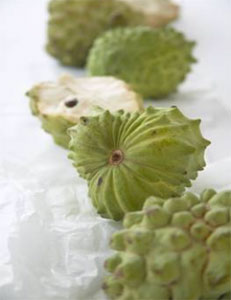Beef Korma Curry with Custard Apple

Beef Korma Curry with Custard Apple
Preparation time: 5 minutesCooking time: 30 minutes
Serves: 4
Ingredients:
1 tablespoon olive oil
400 grams chuck steak, trimmed of all visible fat, thinly sliced
1 large brown onion, chopped
3 tablespoons Korma curry paste
300 grams pumpkin, cut into 2cm pieces
2 cups reduced salt chicken stock
1 (400gram) tin no added salt or sugar chopped tomatoes
150 grams green beans, cut into 3cm lengths
1 cup water
2 cups custard apple segments, seeds removed
2 tablespoons fresh lime juice
2 tablespoons natural yoghurt
3 cups cooked jasmine rice
lime wedges to serve
fresh coriander leaves to garnish
Method
1/ In a large heavy based frying pan heat half the olive oil. Brown meat, remove from pan and set aside.
2/ Heat remaining oil, cook onion for 2 minutes or until softened.
3/ Add curry paste to onion, stir well to combine.
4/ Return meat to pan with pumpkin, tomatoes and 2 cups of stock, stir well to combine. Bring to boil, reduce heat, cover and simmer for 15 minutes.
5/ Meanwhile, to make puree, blend 1 p cups custard apple segments with lime juice in a food processor or blender until smooth. Cover and refrigerate until needed.
6/ Add beans and 1 cup water to frying pan, simmer, uncovered for 5 minutes.
7/ Remove cover add beans and 1 cup stock. Simmer for 5 minutes.
8/ Remove pan from heat, stir through custard apple segments, 1/2 cup custard apple puree and yoghurt.
9/ Serve curry immediately with rice, lime wedges and remaining custard apple puree. Garnish with coriander.
This recipe works well with lamb and chicken also.
The pumpkin can be replaced with sweet potato if desired

Custard Apples, The healthy sweet treats are back.
The time has come for those longing for the luscious, sweet and creamy taste of the glorious custard apple with the season now underway!More and more people are gradually learning the secret that custard apples will also pair with many meal choices, whether sweet, savoury or even as a cocktail inclusion.
You can also feed custard apples to toddlers, by simply mashing custard apple and banana with squeezed orange juice giving them a quick, healthy and ?treat? like snack.
With custard apples being a low GI food, they are a healthy, sweet option that help reduce overeating and assist those with diabetes to control their blood glucose levels. They are also packed full of vitamin C, potassium and other nutrients our bodies need on a daily basis.
Custard apples are natives of South America but Queensland is one of the world?s largest commercial producers. Despite the recent heavy rains in Queensland, the industry is expecting an above average quality harvest in 2008.
Available March to October in supermarkets and all good grocers, you simply have to buy a few and indulge in a healthy sweet treat.
Health and Nutrition
Did you know...?
MORE





